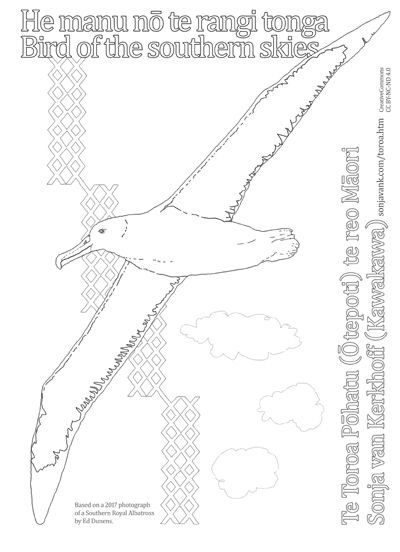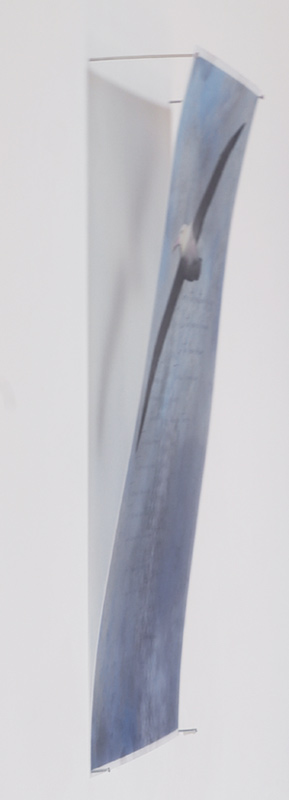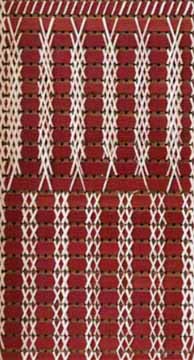![]() Latest work Sonja's c.v. Choose by Medium Prints A tour via thumbnail images
Latest work Sonja's c.v. Choose by Medium Prints A tour via thumbnail images

Link to the a4 page you can print out
Nā Te Toroa Pōhatu te reo Māori
| Maori text by Toroa Pōhatu
Based on this 2017 photo of a Southern Royal Albatross
seen from Victoria, Australia by Ed Dunens.
The Creative Commons copyright means you are
welcome to print and copy the pdf and to use this
for non-commerical use and without changing this image.
This colouring in page was made in response to Auckland being in lockdown and the exhibition, "Where Will the Seabirds go" curated by Val Culbert also being in suspense due to lockdown.
This is one of two exhibitions I am involved in that are in suspense and I have been thinking about how we can use media to deal with lockdown. Here is a page you can print out and colour in, wherever you are.
Te Toroa | The Albatross
I chose the albatross (Toroa in the Māori language) because "Toroa" was one of the first Māori words I learnt in the 1980s, being the name of my lecturer at Otago University, who also translated the poem that is part of this work. For details about this digital poem/print click here
The Otago Peninsula is the only place in Aotearoa | New Zealand where the albatross nest on the mainland. Toroa's name has a connection with Parihaka (where descendents of Te Whiti wear the three white albatross feathers), and my eldest son is named Toroa.
The geometric pattern behind the drawing of the bird is the tukutuku roimata toroa (the tears of the albatross panel pattern) which is common in woven panels in Māori meeting houses across Aotearoa / New Zealand. I knew of this pattern before I learned the name of it.
Albatross tears are very salty because
they drink from the sea while in flight. This enables them to live at sea for years (reuters.com). So in this sense, they symbollize endurance - day by day (ia rā, ia rā), everyday strength. Link to my print: He manawa piharau | Endurance
I have juxtaposed the enduring gliding albatross with a symbol for regret, sorrow or misadventure, as tears often are expressed in many cultures.

The print, He toroa whakakopa | Staying the course
Whakakopa means gliding.
Here is a link to carver Pine Taiapa of the East coast (Ngāti Porou) speaking of the ancestor Pourangahua bringing kūmara (sweet potato) to Aotearoa. Pourangahua was accompanied by two albatrosses sent by the tōhunga (expert), Ruakapanga. On his arrival in Aotearoa, he forgot to say prayers of thanks, and prayers for the safe return of the birds to Hawaiki, as he had been instructed. The birds wept, staining their breasts. Elsewhere Pine Taiapa speaks of Pourangahua being carried by these birds, Harongara and Tiungara.
A Ngāti Porou variation of the short and long vertical pattern, refers to one albatross crying with short tears and the other long tears (See an image here).

Detail of a 1967 Roimata Toroa
Tukutuku panel in
the Aotea Meeting House at
Mākirikiri Marae, Dannevirke,
in the centre of the lower North Island.
Source for the photo above
This page shows four variations of the "roimata toroa" pattern: christchurchcitylibraries.com
Here is a link to an image of a 1993 "roimata toroa" pattern alternated with "ngā Whetū" (the stars) pattern in the Tauranga Library by Wiki Bidois and Potahi Anderson, where the tears symbollise misadventure and the stars are dreams.
See this insightful 2017 article in Pacific Journalism Monographs,
Roimata Toroa | Tears of the Albatross
by Natalie Robertson,
where she connects the 'short-cut' Pourangahua took in forgetting to take time to give thanks which resulted in tragedy to the albatross, to the 'short-cut' of the Greek owned container ship, the Rena which hit the Otaiti (Astrolabe) reef on the East coast in 2011.
This is "New Zealand's worst maritime environmental disaster, spilling hundreds of tonnes of oil into the ocean, as well as containers of hazardous materials."
(p 19, Pacific Journalism Monographs, no. 7, 2017) This 'short-cut' caused the deaths of over 2,000 seabirds (wikipedia.org), including many toroa.
The way I have arranged the rectangular blocks of this tukutuku pattern references another tukutuku pattern, the poutama or poutama karakia (prayer stairway/steps). This conceptual juxtapostion of tears falling and stairs rising is a reference to a Māori concept of the world as forces in balance in organic shifting relationships.